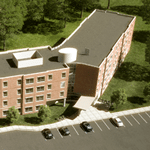A new residence hall was needed at Rose-Hulman Institute of Technology because of growing enrollment, but choosing to make it LEED Silver-certified was an added bonus that proved the school’s commitment to sustainability. With an enrollment of approximately 1,950 undergraduate students, the school, in Terre Haute, Indiana, didn’t have enough on-campus housing to accommodate all of its students. Now, the new 240-bed, 75,000-square-foot residence hall satisfies the school’s desire to attract upperclassmen back to the benefits of campus life.
Living on campus in a small-school environment has its advantages, says Dale Long, Rose-Hulman’s director of news services. “Many of our upperclass students lived in apartments two or three miles away, and those students did not have the same community experience of living on campus,” he says. “Living on campus leads to students taking full advantage of what the school has to offer.”
Rose-Hulman will have doubled its campus residence living spaces since it opened a 217-student residence hall in 1999 and its first apartment-style residence hall, housing 240 upper-level students, in 2004. The new LEED Silver project is similar in program to the apartment-style residence hall but adds sustainable features. It is a four-story building that offers the latest amenities in residence living arrangements with apartment- and suite-style rooms. The project not only reflects Rose-Hulman’s commitment to sustainability, formalized in 2007 when the school signed on to the Presidents’ Climate Commitment, but also helps define standards the school can use on future projects.
The new residence hall is a learning lab and a boon to the area. Ralph Wagle, president of Garmong Construction Services and his son, Jake, a project manager, are both Rose-Hulman civil engineering alumni and gave Rose-Hulman student groups tours throughout the project, showcasing the project’s sustainable aspects. Additionally, the $17 million construction project, designed by RATIO Architects of Indianapolis, was the largest construction project in Vigo County in 2012. It provided a significant economic impact to the Wabash Valley, with as many as 125 workers on-site during peak construction periods.
Further supporting the region, the project utilized locally made materials including thin brick precast made by Gate Precast of Winchester, Kentucky, hollow-core precast by deAM-RON Building Systems of Owensboro, Kentucky, steel by Service Steel Framing of Butler, Indiana, drywall by National Gypsum of Shoals, Indiana, and cabinets by Haas Cabinets of Sellersburg, Indiana.
Jake Campbell, the school’s manager for environmental health and safety, says natural daylighting is a vital feature. The building is constructed on an east/west axis to maximize southern sun exposure and natural ventilation. The building entry and stairwell is a dramatic wall of glass with curtain walls on two sides. The building has two wings that extend out at slight angles from the glass-enclosed central corridor.
The first floor of the hall has been set aside as suite-style rooms for sophomore students. The top three floors have apartment-style living with common areas and individual bedrooms. “Every room has an operable window and individual thermostatic controls,” Campbell says. “The only rooms without daylighting are mechanical rooms and housekeeping.”

